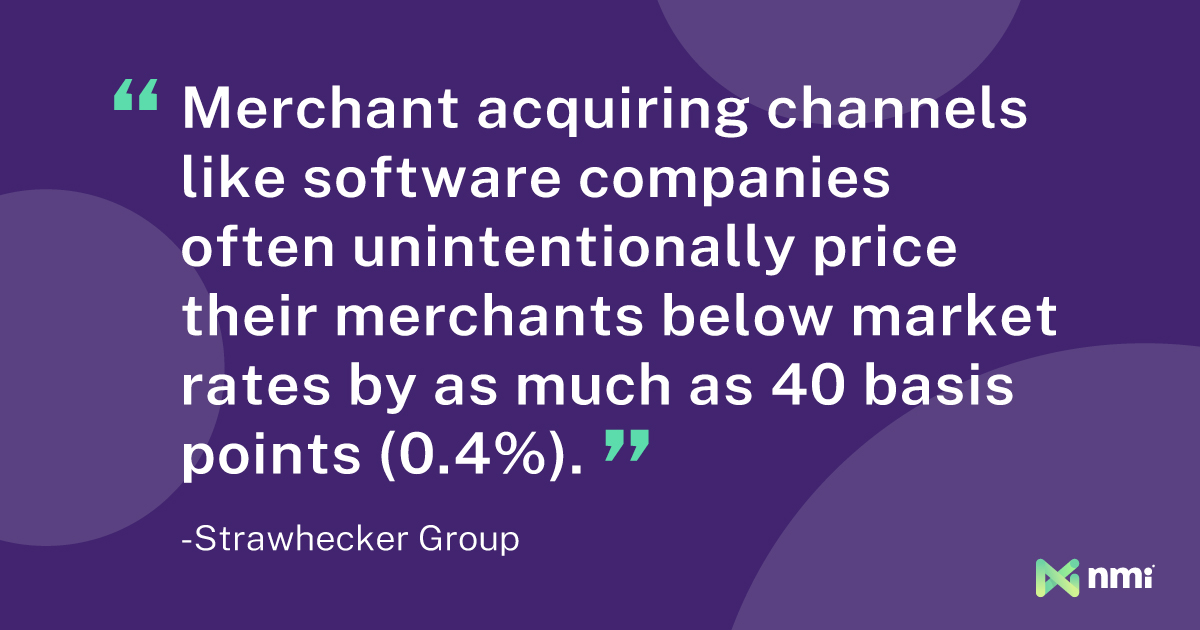Optimized merchant pricing is vital in maintaining the balance between merchant satisfaction and revenue generation. It ensures that acquirers and merchants both win. Meanwhile, unoptimized pricing leads to an imbalance that either costs the acquirer potential revenue or charges the merchant too much.
Without the right balance, you risk losing your merchants to a competitor. It’s a delicate process—one far too many acquirers get wrong.
Research from the Strawhecker Group shows that acquirers often underprice their merchants without realizing it. In some cases—like software payments —processing is underpriced by as much as 0.4%. That’s a significant error, considering transaction fees are normally in the one to three percent range.
With the industry in a constant state of flux, it’s difficult to ensure optimization in merchant pricing. Today, forward-thinking acquirers are using automated systems and data-driven approaches to tackle the problem. With the right data, you can help merchants maximize fee revenue without driving business toward cheaper competitors.
Understanding Merchant Pricing
Merchant pricing involves the various fees payment processors charge to merchants for handling electronic transactions. These fees can include transaction fees, monthly service fees, and other charges for value-added merchant services.
In the payments industry, market rates for these fees vary depending on factors such as transaction volume, type of transaction, type of card used and the risk associated with a particular merchant. The baseline for fees always starts with the interchange rates set by major card networks. Beyond those base rates, you have a lot of room to adjust your markups.
Many merchant acquirers choose to price slightly below market rates as a competitive strategy. However, problems arise when their rates don’t match the market. Unfortunately, that’s an easy oversight to make, especially with a portfolio of thousands of merchants.
The Damage Done by Under-Optimized Merchant Pricing
Overcharging merchants is bad for business. However, undercharging can be equally bad for the following reasons:
- Lost Revenue: Charging merchants below market rates may attract more businesses initially, and it can be effective for promotional purposes. However, when under-optimized pricing is unintentional and goes unnoticed, it can result in significant losses. In some cases, lost revenue can cancel out profits brought in by newer, properly priced accounts
- Shocking Price Increases: Unintentional undercharging can lead to a significant gap between what a merchant is paying and what the market commands. If an acquirer catches such an error, closing the gap may require a large price increase that will be difficult for a merchant to swallow. Conversely, tracking market changes and raising merchant prices in small increments over time will lead to fewer issues
- A Race to the Bottom: Below-market pricing, whether intentional or accidental, forces acquirers to cut rates to compete. Maintaining optimized pricing is good for the industry as a whole. It ensures that charged fees are enough to make processing worthwhile for everyone involved

The Data-Driven Approach to Pricing Optimization
Modern digital payments produce an enormous amount of information. A data-driven approach to merchant pricing uses large sets of information gathered from various sources. The right data can help you make informed pricing decisions and improve your long-term strategy.
Here’s how data can aid in keeping transaction fees in line with going rates:
- Market Analysis: The first step is to conduct a market analysis. By analyzing market and portfolio-wide data, you can better understand pricing trends and make decisions accordingly
- Merchant Segmentation: Data analytics allow you to accurately categorize merchants based on different factors like size, industry and risk. This segmentation enables tailored pricing strategies that reflect the true cost of serving each segment
- Risk Assessment: Merchants are priced based on their risk profile. Higher-risk merchants are generally charged more to cover potential losses. This ensures that total fees are in line with the market. Using merchant data and automated ongoing risk assessment tools enables you to track real-time changes in merchant risk
- Performance Tracking: Ongoing monitoring of pricing performance through data analysis can help you make timely adjustments. It ensures that pricing remains both profitable and aligned with market dynamics
- Merchant-by-Merchant Tracking: Good merchant data and reporting tools allow acquirers to track individual merchants within a portfolio of thousands. Identifying specific merchants that are being both over- and under-charged will enable you to make corrections before pricing problems arise or valuable relationships degrade
Technology in Data-Driven Pricing
Technological innovations are fueling the data-driven approach to merchant pricing. New technologies enable predictive modeling, automation and real-time adjustments. The data has always been there, but the tools necessary to turn it into useful business intelligence are now more accessible and affordable.
Payments CRMs—The Ultimate Tool for Useful Data Generation
Customer data is powerful because of its sheer volume. Every customer interaction, every click on your site and every transaction culminate into helpful behavioral data. Unfortunately, too much data can be challenging to keep up with. Faced with a sea of information, many acquirers don’t know how to collect, manage, or use it. Enter the customer relationship management platform (CRM).
A payments-specific CRM is designed specifically to collect and harness the enormous volume of data independent sales organizations (ISOs), payment facilitators (PayFacs) and independent software vendors (ISVs) generate through normal operations. It automatically collects key data and makes it available in an intuitive, easy-to-use reporting dashboard.
In essence, a CRM is a solution that turns raw merchant data into usable business intelligence. It allows you to use the information instead of drowning in it.
The data collected by a CRM can be used to identify pricing inefficiencies. It can also create more efficient sales funnels, build stronger relationships with leads, shorten time-to-close, automate residual calculations and more.
Automated Risk Assessments and Monitoring
You can also use underwriting software to make data the center of pricing. Automated underwriting software uses data analysis to perform accurate and consistent risk assessments on merchants.
You can assess new merchants using the information included in merchant processing applications (MPA). This allows for more complete underwriting and more accurate initial pricing. The software also monitors merchants in the background for the lifetime of their selling activity.
A great underwriting tool will constantly monitor merchant data as they sell and look for shifts in their risk profile. The system can identify everything from changes in volume and suspicious activity to sales outside of a known merchant category code (MCC) and more.
Underwriting is a continuous process. The result is that any change that might impact a merchant’s pricing will quickly be reported, enabling you to make proper adjustments.
Better Pricing Optimization With NMI’s Modular Merchant Solutions
Properly optimized merchant pricing is a crucial aspect of success in payments. Charging above or below market rates can lead to many challenges, impacting not only the payment processor but also the entire ecosystem.
Embracing a data-driven approach to merchant pricing offers a reliable solution to the challenges of maintaining optimized merchant pricing in a constantly shifting market. NMI’s modular merchant solutions provide ISOs, PayFacs and ISVs with the tools needed to optimize their pricing strategy.
To learn more about how NMI’s MRM and automated underwriting systems can help your company optimize pricing and maximize revenue, reach out to a member of our team today.




